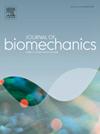Ability of a passive back support exoskeleton to mitigate fatigue related adaptations in a complex repetitive lifting task
IF 2.4
3区 医学
Q3 BIOPHYSICS
引用次数: 0
Abstract
As work related musculoskeletal disorders (WRMSDs) increase in prevalence, it is important to not only understand the mechanisms underpinning WRMSDs but also investigate ways to mitigate them in the workplace. Exoskeletons are an emerging technology which can reduce the physical demands required from the worker to perform lifting tasks. Previous research has primarily studied the effectiveness of back-support exoskeletons in constrained, flexion/extension tasks. The purpose of this study was to evaluate the effect of a passive back-support exoskeleton in a complex, multiplanar repetitive manual materials handling (MMH) task. Participants (n = 14) completed a multi-planar lifting, transferring, and lowering task for sixty minutes with and without wearing a passive back-support exoskeleton (HeroWear Apex 2). Full body kinematics as well as trunk and shoulder surface electromyography were collected for the entire trial. The back-support exoskeleton significantly decreased ratings of perceived exertion (p < 0.0001) Participants exhibited faster task completion times in the exoskeleton condition (p = 0.0095). Both movement coordination and coordination variability differed between conditions with increased shoulder-lumbar variability (p = 0.0466 − <.0001) and decreased thorax-pelvis variability (p = 0.0281) in the exoskeleton condition. Additionally, the back-support exoskeleton significantly reduced lumbar erector spinae muscle activity asymmetrically (p < 0.0001). While these findings generally support the idea that a passive back-support exoskeleton is effective in altering indicators of fatigue which can lead to injury, more research is needed to study different exoskeleton assistance levels and different types of exoskeletons before recommending their use across a diverse range of occupational settings.
求助全文
约1分钟内获得全文
求助全文
来源期刊

Journal of biomechanics
生物-工程:生物医学
CiteScore
5.10
自引率
4.20%
发文量
345
审稿时长
1 months
期刊介绍:
The Journal of Biomechanics publishes reports of original and substantial findings using the principles of mechanics to explore biological problems. Analytical, as well as experimental papers may be submitted, and the journal accepts original articles, surveys and perspective articles (usually by Editorial invitation only), book reviews and letters to the Editor. The criteria for acceptance of manuscripts include excellence, novelty, significance, clarity, conciseness and interest to the readership.
Papers published in the journal may cover a wide range of topics in biomechanics, including, but not limited to:
-Fundamental Topics - Biomechanics of the musculoskeletal, cardiovascular, and respiratory systems, mechanics of hard and soft tissues, biofluid mechanics, mechanics of prostheses and implant-tissue interfaces, mechanics of cells.
-Cardiovascular and Respiratory Biomechanics - Mechanics of blood-flow, air-flow, mechanics of the soft tissues, flow-tissue or flow-prosthesis interactions.
-Cell Biomechanics - Biomechanic analyses of cells, membranes and sub-cellular structures; the relationship of the mechanical environment to cell and tissue response.
-Dental Biomechanics - Design and analysis of dental tissues and prostheses, mechanics of chewing.
-Functional Tissue Engineering - The role of biomechanical factors in engineered tissue replacements and regenerative medicine.
-Injury Biomechanics - Mechanics of impact and trauma, dynamics of man-machine interaction.
-Molecular Biomechanics - Mechanical analyses of biomolecules.
-Orthopedic Biomechanics - Mechanics of fracture and fracture fixation, mechanics of implants and implant fixation, mechanics of bones and joints, wear of natural and artificial joints.
-Rehabilitation Biomechanics - Analyses of gait, mechanics of prosthetics and orthotics.
-Sports Biomechanics - Mechanical analyses of sports performance.
 求助内容:
求助内容: 应助结果提醒方式:
应助结果提醒方式:


